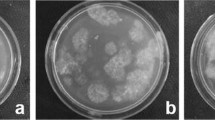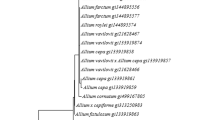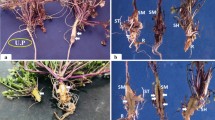Abstract
Bremia lactucae Regel (Chromista, Peronosporaceae) is an economically destructive pathogen, which causes downy mildew disease on lettuce (Lactuca sativa L.) worldwide. The ribosomal internal transcribed spacer (ITS) of Bremia lactucae isolates was analyzed for the first time. The ITS region of lettuce downy mildew was observed to have a size of 2458 bp; thereby, having one of the longest ITS sizes recorded to date. The majority of the extremely large sized ITS2 length of 2086 was attributed to the additional presences of nine repetitive elements with lengths of 179–194 bp, which between them shared the low homology of 48–69%. Comparison of the ITS2 sequences with the B. lactucae isolates from other host plants showed that isolates present on Lactuca sativa were distinct from those on L. indica var. laciniata, as well as Hemistepta and Youngia. We suggest the high degree of sequence heterogeneity exhibited in the ITS2 region of B. lactucae may warrant the specific detection and diagnosis of this destructive pathogen or its division into several distinct species.
Similar content being viewed by others
References
Crute IR (1981). The host specificity of peronosporaceous fungi and the genetics of the relationship between gost and parasite. In: Spencer, DM (eds) The Downy Mildews, pp 237–53. Academic Press, London
Lebeda A, Pink DAC and Mieslerovora B (2002). Aspects of the interactions between wild Lactuca spp. and related genera and Lettuce Downy Mildew (Bremia lactucae). In: Spencer-Phillips, PTN, Gisi, U, and Lebeda, A (eds) Advances in Downy Mildew Research, pp 85–17. Kluwer Academic Publishers, Dordrecht 10.1007/0-306-47914-1_3
Sawada K. Descriptive catalogue of the formosan fungi. Agric Exp Sta Gov Formosa, Spec Bull, 1919; no. 19
Ito S and Tokunaga Y (1935). Notae mycologicae asiae orientalis. I. Trans Sapporo Nat Hist Soc 14: 11–3
Sydow H (1923). Mycotheca germanica Fasc. 37–1 (Nrs. 1801–050). Ann Myc 21: 165–81
Sydow H (1938). Mycotheca germanica Fasc. 61–4 (Nrs. 3001–200). Ann Myc 26: 318–25
Ul’yanishchev VI, Osipian LL, Kanchaveli LA and Akhundov TM (1985). Peronosporovye Griby. (Peronosporaceous Fungi). In: Ul’yanishchev, VI (eds) Opredelitel’ Gribov Zakavkaz’ya, pp. Erevan University, Erevan
Stanyavichene S (1984). Peronosporovye griby Pribltiki. [Peronosporaceous fungi of the Baltic States]. Mokslas, Vilnius
Staneviciené S (1995). Peronosporales. In: Mazelaitis, J and Staneviciené, S (eds) Lietavos Grybai. I. Gleivunai (Myxomycota), Peronosporieciai (Peronosporales), pp 85–91. Mokslo ir Enciklopediju Leidykla, Vilnius
Yu Y-n, Zhung W-y, Liu X-j, Ma G-z, Li J-l, Yin G-y, Yang Z-s, Tao J-f, Shen Y-z, Wang Y-x and Liu Y-l (1998). Flora Fungorum Sinicorum 6: Peronosporales. Science Press, Beijing
Ling L and Tai MC (1945). On the specialization of Bremia lactucae on Compositae. Trans Brit Mycol Soc 28: 16–5
Skidmore DI and Ingram DS (1985). Conidial morpholgy and the specialization of Bremia lactucae Regel (Peronosporaceae) on hosts in the family Compositae. Bot J Linn Soc 91: 503–22
Riethmüller A, Voglmayr H, Göker M, Weiß M and Oberwinkler F (2002). Phylogenetic relationships of the downy mildews (Peronosporales) and related groups based on nuclear large subunit ribosomal DNA sequences. Mycologia 94: 834–49
Göker M, Voglmayr H, Riethmüller A, Weiß M and Oberwinkler F (2003). Taxonomic aspects of Peronosporaceae inferred from Bayesian molecular phylogenetics. Can J Bot 81: 672–83
Voglmayr H, Riethmuller A, Goker M, Weiss M and Oberwinkler F (2004). Phylogenetic relationships of Plasmopara, Bremia and other genera of downy mildew pathogens with pyriform haustoria based on Bayesian analysis of partial LSU rDNA sequence data. Mycol Res 108: 1011–024
Voglmayr H (2003). Phylogenetic relationships of Peronospora and related genera based on nuclear ribosomal ITS sequences. Mycol Res 107: 1132–142
Lee SB and Taylor JW (1990). Isolation of DNA from fungal mycelia and single spores. In: Innis, MA, Gelfand, DH, Sninsky, JJ and White, TJ (eds) PCR protocols: A guide to methods and applications, pp 282–87. Academic Press, San Diego
Cooke DEL, Drenth A, Duncan JM, Wagels G and Brasier M (2000). A molecular phylogeny of Phytophthora and related Oomycetes. Fungal Genet Biol 30: 17–2
Moncalvo JM, Wang HH and Hseu RS (1995). Phylogenetic relationships in Ganoderma inferred from the internal transcribed spacer and 25S ribosomal DNA sequences. Mycologia 87: 223–38
White TJ, Bruns T, Lee S and Taylor JW (1990). Amplification and direct sequencing of fungal ribosomal RNA genes for phylogenetics. In: Innis, MA, Gelfand, DH, Sninsky, JJ, and White, TJ (eds) PCR protocols: A guide to methods and applications, pp 315–22. Academic Press, San Diego
Thompson JD, Higgins DG and Gibson TJ (1994). Clustal W: improving the sensitivity of progressive multiple sequence alignment through sequence weighting, position specific gap penalties and weight matrix choice. Nucleic Acids Res 22: 4673–680
Posada D and Crandall KA (1998). Modeltest: testing the model of DNA substitution. Bioinformatics 14: 817–18
Swofford DL. PAUP*. phylogenetic analysis using parsimony (*and other methods). Version 4. Sunderland, Massachusetts, USA: Sinauer Associates, 2002.
Zuker M (2003). Mfold web server for nucleic acid folding and hybridization prediction. Nucleic Acids Res 31: 3406–415
Bonants PJM, Hagenaar DVM, Lacourt I, Cooke DEL and Duncan JM (1997). Detection and identification of Phytophthora fragariae Hickman by the polymerase chain reaction. Eur J Plant Pathol 103: 345–55
Lévesque CA (2004). Molecular phylogeny and taxonomy of the genus Pythium. Mycol Res 108: 1363–383
Leclerc MC, Guillot J and Deville M (2000). Taxonomic and phylogenetic analysis of Saprolegniaceae (Oomycetes) inferred from LSU rDNA and ITS sequence comparisons. Anton Leeuw 77: 369–77
Thines M, Komjáti H and Spring O (2005). Exceptional length of ITS in Plasmopara halstedii in due to multiple repetitions in the ITS-2 region. Eur J Plant Pathol 112: 395–98
Author information
Authors and Affiliations
Corresponding author
Rights and permissions
About this article
Cite this article
Choi, YJ., Hong, SB. & Shin, HD. Extreme size and sequence variation in the ITS rDNA of Bremia lactucae . Mycopathologia 163, 91–95 (2007). https://doi.org/10.1007/s11046-007-0092-7
Received:
Accepted:
Published:
Issue Date:
DOI: https://doi.org/10.1007/s11046-007-0092-7




